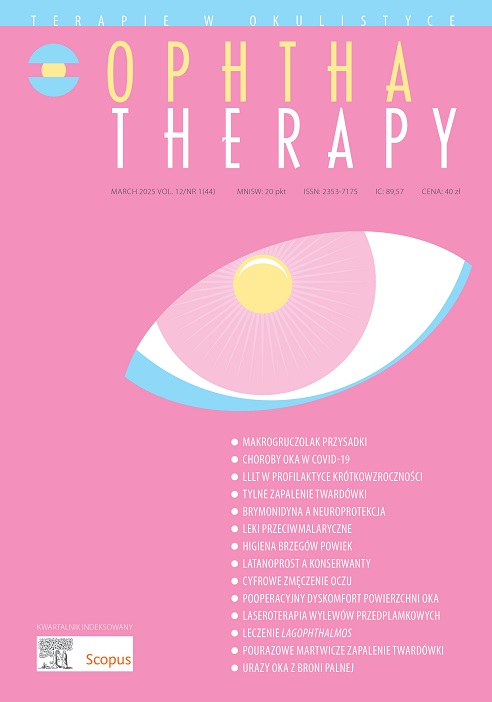Patient treated with antimalarial drug under the supervision of a rheumatologist and ophthalmologist Review article
Main Article Content
Abstract
Patients who come to see an ophthalmologist often have systemic diseases, the treatment of which can affect the condition of the eye. Such medications include the so-called antimalarial drugs chloroquine and hydroxychloroquine, which are used in the treatment of systemic lupus erythematosus or rheumatoid arthritis. During their use, regular ophthalmological follow-up is necessary.
In the early stages of antimalarial use, patients are usually asymptomatic, while advanced maculopathy or peripheral retinopathy can cause irreversible vision loss. The main risk factors for maculopathy are high doses (more than 5 mg/kg/24 h for hydroxychloroquine) and a long duration of use (greater than 5 years). Renal or liver impairment or concomitant use of tamoxifen increase the risk of ocular damage. Risk factors also include age and concurrent retinal disease.
Ophthalmic screening should include evaluation of visual acuity, colour vision, Amsler test, fundus and additional tests such as optical coherence tomography, electroretinogram, fundus autofluorescence, and visual field. The decision to discontinue the drug should be made jointly with the rheumatologist or attending physician, after taking into account the systemic effects of the drug.
Downloads
Article Details
Copyright: © Medical Education sp. z o.o. License allowing third parties to copy and redistribute the material in any medium or format and to remix, transform, and build upon the material, provided the original work is properly cited and states its license.
Address reprint requests to: Medical Education, Marcin Kuźma (marcin.kuzma@mededu.pl)
References
2. Medycyna Praktyczna. Chlorochina.
3. Nirk EL, Reggiori F, Mauthe M. Hydroxychloroquine in rheumatic autoimmune disorders and beyond. EMBO Mol Med. 2020; 12(8): e12476.
4. An J, Minie M, Sasaki T et al. Antimalarial Drugs as Immune Modulators: New Mechanisms for Old Drugs. Annu Rev Med. 2017; 68: 317-30.
5. Fanouriakis A, Kostopoulou M, Andersen J et al. EULAR recommendations for the management of systemic lupus erythematosus: 2023 update. Ann Rheum Dis. 2024; 83(1): 15-29.
6. Smolen JS, Landewé RBM, Bergstra SA et al. EULAR recommendations for the management of rheumatoid arthritis with synthetic and biological disease-modifying antirheumatic drugs: 2022 update. Ann Rheum Dis. 2023; 82(1): 3-18.
7. Siegel CH, Sammaritano LR. Systemic Lupus Erythematosus: A Review. JAMA. 2024; 331(17): 1480-91.
8. Olesińska M, Goncerz G, Musiał J et al. Toczeń rumieniowaty układowy. In: Interna Szczeklika 2024. Gajewski P, Jaeschke R (eds.). Medycyna Praktyczna, Kraków 2024: 2090-102.
9. Filipowicz-Sosnowska A. Reumatoidalne zapalenie stawów. In: Interna Szczeklika 2024. Gajewski P, Jaeschke R (eds.). Medycyna Praktyczna, Kraków 2024: 2072-88.
10. Quiñones ME, Joseph JK, Dowell S et al. Hydroxychloroquine and Risk of Long QT Syndrome in Rheumatoid Arthritis: A Veterans Cohort Study With Nineteen-Year Follow-up. Arthritis Care Res (Hoboken). 2023; 75(7): 1571-9.
11. Levy GD, Munz SJ, Paschal J et al. Incidence of hydroxychloroquine retinopathy in 1,207 patients in a large multicenter outpatient practice. Arthritis & Rheumatism. 1997; 40(8): 1482-6.
12. Medycyna Praktyczna. Hydroksychlorochina.
13. Schrezenmeier E, Dörner T. Mechanisms of action of hydroxychloroquine and chloroquine: implications for rheumatology. Nat Rev Rheumatol. 2020; 16(3): 155-66.
14. Tang C, Godfrey T, Stawell R et al. Hydroxychloroquine in lupus: emerging evidence supporting multiple beneficial effects. Intern Med J. 2012; 42(9): 968-78.
15. Costa EA, Gonçalves AP, Batista JAD et al. New Insights into the Mechanism of Action of the Drug Chloroquine: Direct Interaction with DNA and Cytotoxicity. J Phys Chem B. 2022; 126(19): 3512-21.
16. Peponis V, Kyttaris VC, Chalkiadakis SE et al. Ocular side effects of anti-rheumatic medications: what a rheumatologist should know. Lupus. 2010; 19(6): 675-82.
17. Marmor MF, Kellner U, Lai TY et al. Recommendations on Screening for Chloroquine and Hydroxychloroquine Retinopathy (2016 Revision). Ophthalmology. 2016; 123(6): 1386-94.
18. Easterbrook M. Detection and prevention of maculopathy associated with antimalarial agents. Int Ophthalmol Clin. 1999; 39(2): 49-57.
19. Wiacek MP, Bobrowska-Snarska D, Lubiński W et al. What is new in recommendations on ophthalmological screening in patients treated with chloroquine and hydroxychloroquine? Update and literature review. Niger J Clin Pract. 2017; 20(8): 919-23.
20. Yam JC, Kwok AK. Ocular toxicity of hydroxychloroquine. Hong Kong Med J. 2006; 12(4): 294-304.
21. Hirooka K, Tokuda M, Miyamoto O et al. The Ginkgo biloba extract (EGb 761) provides a neuroprotective effect on retinal ganglion cells in a rat model of chronic glaucoma. Current Eye Research. 2004; 28(3): 153-7.
22. Bowling B. Kanski Okulistyka kliniczna. Edra Urban & Partner, Wrocław 2017: 854-5.
23. Ahmad R, Mehta H. The ocular adverse effects of oral drugs. Aust Prescr. 2021; 44(4): 129-36.
24. Skrzypiec I, Wierzbowska J. Retinopathy caused by chloroquine or hydroxychloroquine. Lek Wojsk. 2019; 97(1): 65-70.
25. Marmor MF, Carr RE, Easterbrook M et al. Recommendations on screening for chloroquine and hydroxychloroquine retinopathy: a report by the American Academy of Ophthalmology. Ophthalmology. 2002; 109(7): 1377-82.

